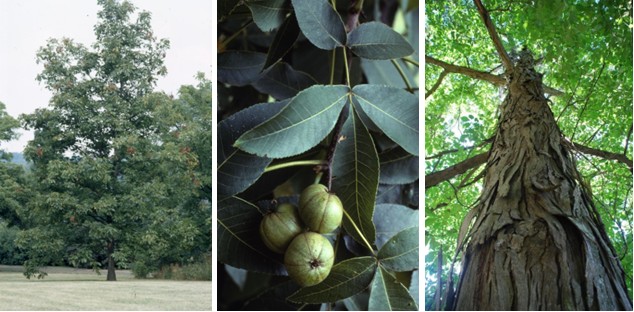Arborvitae/White Cedar: Evergreen tree, commonly sheared for a hedge; light green color; excellent for wildlife food & cover; grows on various soils but prefers moist loamy soils. The American arborvitae grows to a height of 40–60′ and a spread of 10–15′ at maturity. Full sun is the ideal condition for this tree, meaning it should get at least six hours of direct, unfiltered sunlight each day. https://www.arborday.org/trees/treeguide/treedetail.cfm?itemID=776
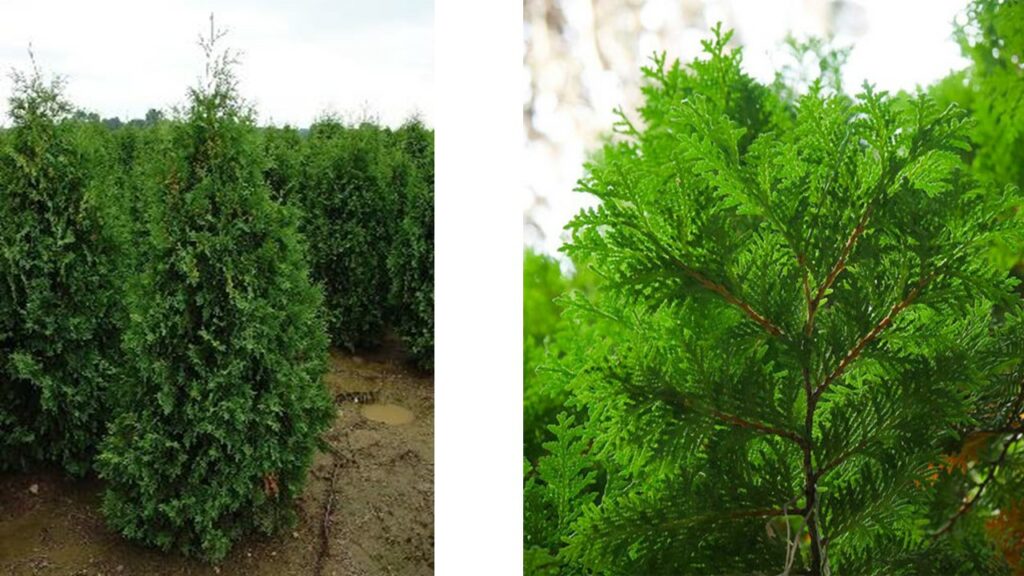
Eastern Redbud: Ideal on residential lawns. Grows 1-1.5’ yearly. Can reach 20-30’ tall. Dark green, heart shaped leaves changing to bright yellow in the fall. Large pink-purple flower clusters in the spring before foliage emerges. Prefers well-drained, nutrient rich soil with a pH over 7.5. Full sun or partial shade. https://www.arborday.org/trees/treeguide/treedetail.cfm?itemID=912
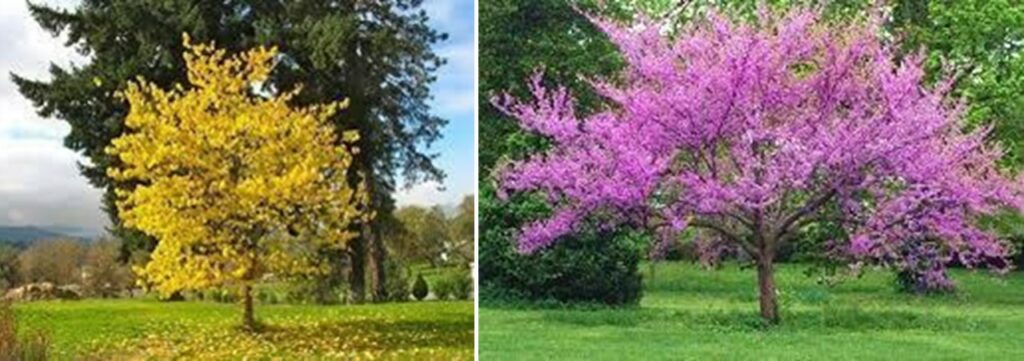
Lilac: Hardy, grows to 15 feet; fragrant lavender flowers which bloom in late spring; space 6 feet for screening; prefers sunny, well drained site. https://www.arborday.org/trees/treeguide/treedetail.cfm?itemID=856

Paw Paw: Drooping pear-shaped leaves, reaches up to 30 ft. at maturity; can be planted in the shade of tall, open trees or in partial shade, although they fruit best in sun; prefers moist, slightly acidic soils and requires regular watering, adaptable to many conditions. https://www.arborday.org/trees/treeguide/TreeDetail.cfm?ItemID=2579
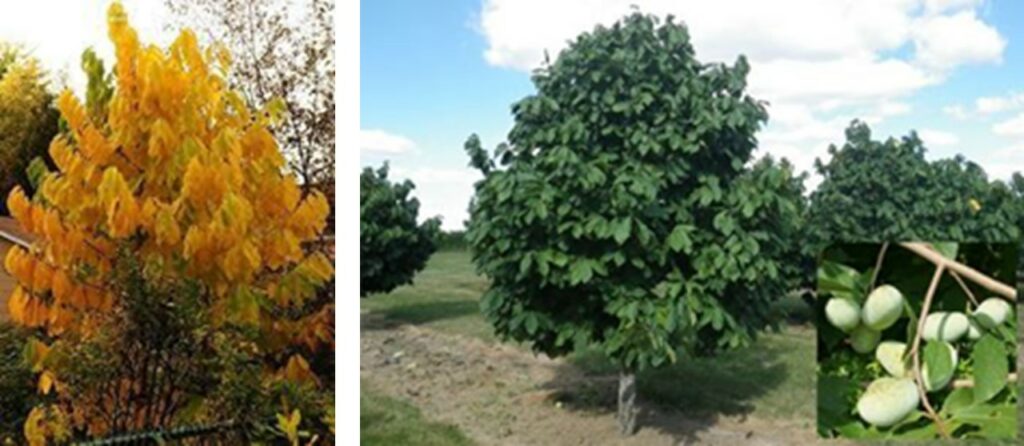
White Flowering Dogwood (Cornus Florida): Grows 20-25 feet at maturity, with a medium growth rate. Prefers partial shade, requires about 4 hours of sunlight a day. The white dogwood is very versatile, growing in acidic, loamy, moist, rich, sandy, well-drained and clay soils. It prefers moist conditions. This tree blooms April-May with distinct white flowers. It produces glossy red fruit eaten by birds and other mammals. In the fall, leaves provide great color, turning red-purple. https://shop.arborday.org/treeguide/280
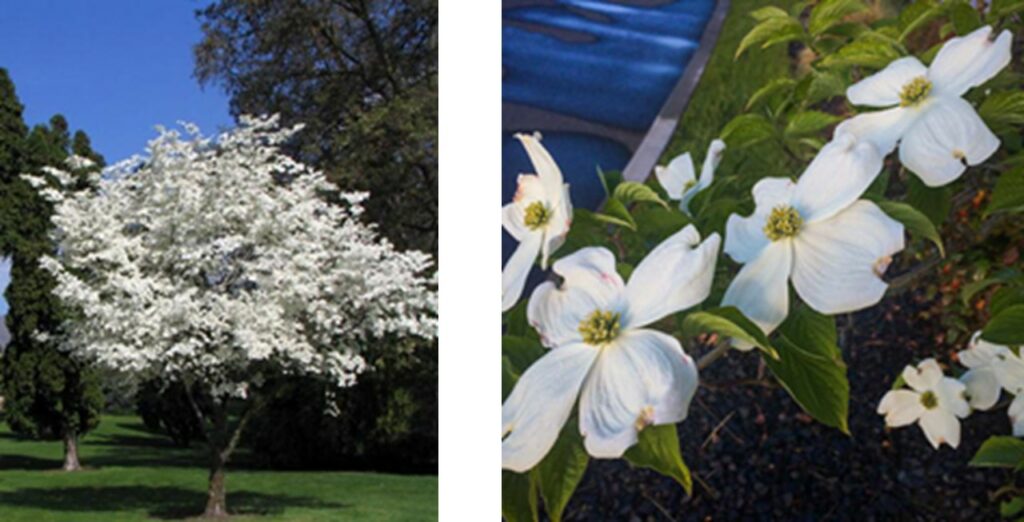
Serviceberrry tree: This native service-berry is usually a multiple-trunked tree or shrub, 15-25 ft. tall, with dense, fine-textured branching. The white blossoms, which can be spectacular in mature specimens, develop from pink buds in spring. Bearing sweet berries turning from red to purple or nearly black. Blue-green summer foliage can become orange or red in fall. The bark is smooth and slate-gray with white, longitudinal stripes. Very easy to grow and provides year-round interest. Berries are edible. https://plants.ces.ncsu.edu/plants/amelanchier/
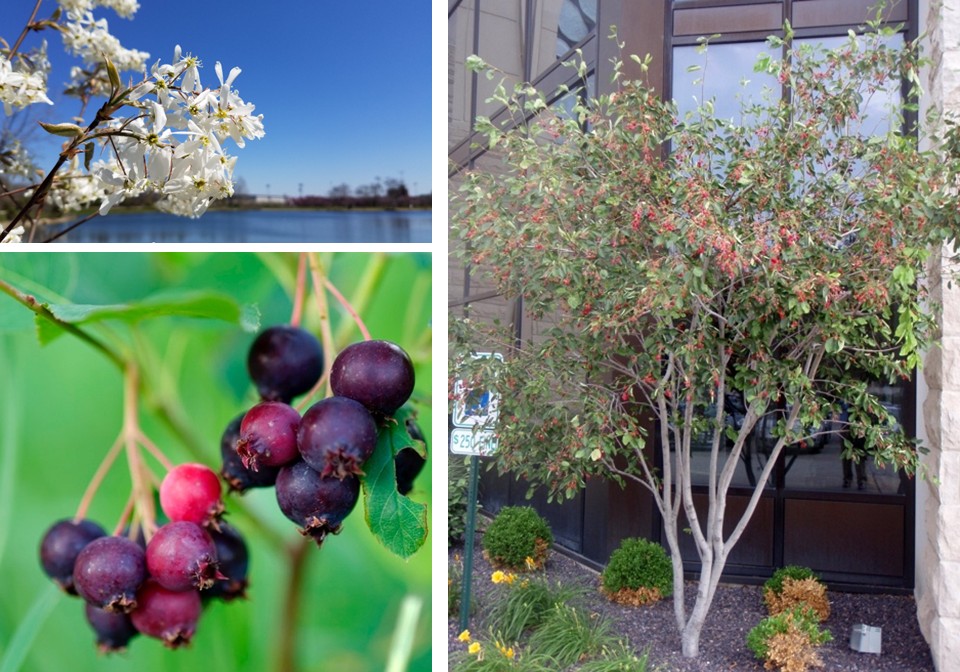
White Spruce: Green, short, sharp-pointed needles; tolerates most soil types as well as cold, wind, heat and drought; pyramidal shape; reaches 50 – 60 feet with a 20’ spread; widely used for lumber, wildlife cover, Christmas trees & windbreak. A densely, pyramidal spire (tapers to a point) with bluish-green needles. Highly adaptable to most areas. This tree prefers full sun. https://shop.arborday.org/treeguide/409
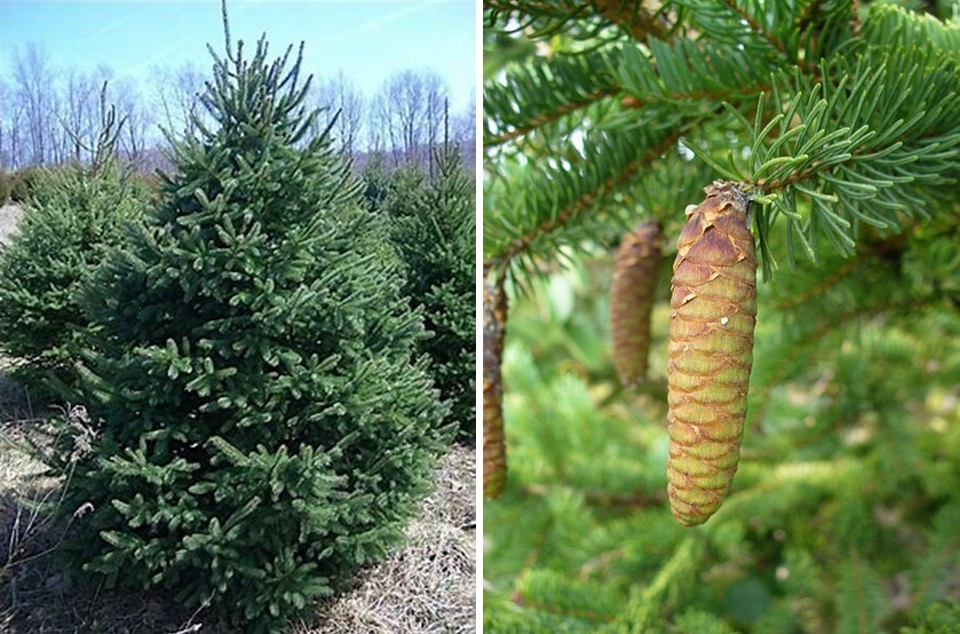
Magnolia (Sweetbay): This tree flowers late in the spring, avoiding much of the frost that can spoil a blooming tree’s beauty. It also attracts a wide variety of songbirds with its fall fruit. The bark is smooth and gray. Grown for its large, conspicuous, scented flowers, for its clean, attractive foliage, and for its fast growth. It grows to a height of 10–20′ and a spread of 10–20′ at maturity. Full sun and partial shade are best for this tree, meaning it prefers a minimum of four hours of direct, unfiltered sunlight each day. This tree grows at a medium to fast rate, with height increases of anywhere from 13″ to more than 24″ per year. https://www.arborday.org/trees/treeguide/treedetail.cfm?itemID=865

Red Maple: Grows 40’-60’and spreads 30’-50’. Prefers full sun to partial sun/shade. Fast growing tolerates most soils particularly wetter soils, maple leaves turn red in the early fall. The fruits (samaras) provide food for squirrels and many other rodents. Rabbits and deer eat the tender shoots and leaves of red maples. https://shop.arborday.org/treeguide/337

River Birch: This tree is often used for landscaping for its graceful drooping limbs and attractive color. A fast-growing, deciduous tree grows under full sun to full shade and best in moist soils. It’s a valuable source of erosion control as well. It produces flowers in spring, leaves turn bright yellow in fall with a silvery trunk in winter. Without pruning, it grows several trunks and can reach over 50’ in height. Once mature, it develops a cinnamon colored bark that curls and peels. Seeds are a food source for many songbirds. https://shop.arborday.org/treeguide/173

Elderberry: This shrub is 5–12 ft. tall, 3–6 ft. wide. The bush produces bluish-black fruit in bunches that are used in wines, juices, jellies, and jams. The berries themselves are quite bitter, so they are rarely eaten by themselves. Growing elderberries is not all that difficult. They can tolerate different conditions like poor soil or overly wet areas. Elderberries cannot tolerate drought. When planting elderberry bushes, you should note that the berries will grow on the bushes the first year you plant them. The berries will do better the second year. Elderberry planting is done best in well-draining, loamy soil. Sandy soils should be improved by adding a few inches (5 to 10 cm.) of organic matter. When elderberry planting, make sure to allow for cross-pollination. Therefore, two or more cultivars can be planted near each other. Plant them one meter apart (3 ft.) in rows that are four to five meters (13 to 16.5 ft.) apart. https://www.thespruce.com/american-elderberry-sambucus-canadensis-3269208
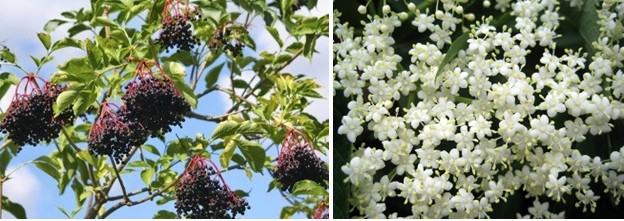
Rose of Sharon: 8-12’ tall deciduous shrub, can be pruned to desired shape. Large, colorful flowers in late summer, grows best in full sun with well drained soils, tolerates dry conditions, attracts hummingbirds. https://shop.arborday.org/treeguide/394?srsltid=AfmBOoo6pzFY-AjsmlLE8XUJZs5imxkh_h_KN-PmE953blr8xLIxNg0I
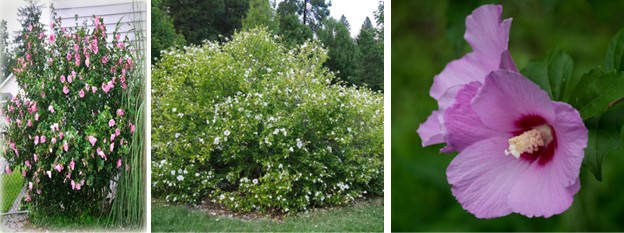
White Oak: Grows 50’-80’ with spread of 50’-80’ at maturity, shade tree capable of blocking sunlight. Slow to medium growth, prefers slightly acidic to neutral, deep, well-drained soil. The common name is a reference to the color of the finished wood, not the bark. This long-lived tree is a prolific supporter of wildlife for food and habitat. It supports a wide variety of butterflies and moths plus small mammals and songbirds. The acorns of white oak are edible (to humans) after tannins are leached or boiled out. https://shop.arborday.org/treeguide/351?srsltid=AfmBOorr2utt0j_nFwuDN_KXN5IKF9jyNrhQ18Bu-faXNg6fyEtEBSVW
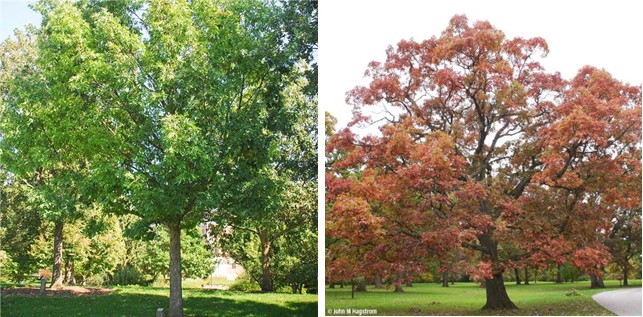
Persimmon: An edible fruit. When ripe, they range in color from light yellow to dark red-orange. Plant in a spot that gets at least 6-8 hours of full sun per day. Can grow very tall to 50’. Prefers slightly acidic and loamy soils. The fruits ripen in late autumn and may remain on the tree into winter, provides a great treat for birds and other wildlife. Deer love this fruit! https://www.missouribotanicalgarden.org/PlantFinder/PlantFinderDetails.aspx?kempercode=h740

Pussy Willow: The fast-growing pussy willow has long been admired for its strong, spreading, upright stems, colorful autumn leaves and iconic purplish-brown catkins that appear in late winter/early spring. Produces soft, purplish-brown catkins along the branches in March. The furry catkins are striking on the bare stems, appearing between seasons when gardens can seem rather blah. Provides great late winter/early spring landscape interest. Can grow as a small tree or large shrub. The pussy willow grows fast with a mature height of 15’-25’ and a mature spread of 12’-25’. It prefers full sun or partial sun/shade and moist, well-drained soil. https://shop.arborday.org/pussy-willow-2
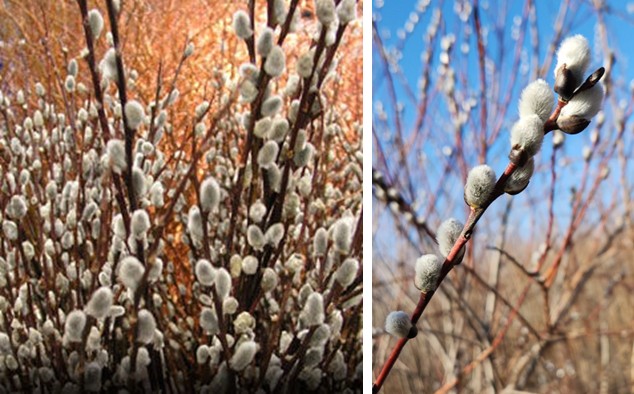
Shagbark Hickory: The shagbark hickory is a long-lived, large tree with a straight trunk, and provides excellent shade. Needs a large yard or naturalized area.This Midwest native is named for its bark, which peels away in large, flat, curving plates, giving the tree a shaggy appearance. As a member of the walnut family, the hickory produces edible nuts. It grows slowly to a mature height of 60’-80’ and mature width of 30’-50’. It prefers full sun or partial sun/shade and moist, well-drained soil. It provides benefits to wildlife such as shelter and food for cavity-nesting birds, game birds, migrant birds, small mammals, and songbirds. https://mortonarb.org/plant-and-protect/trees-and-plants/shagbark-hickory/
